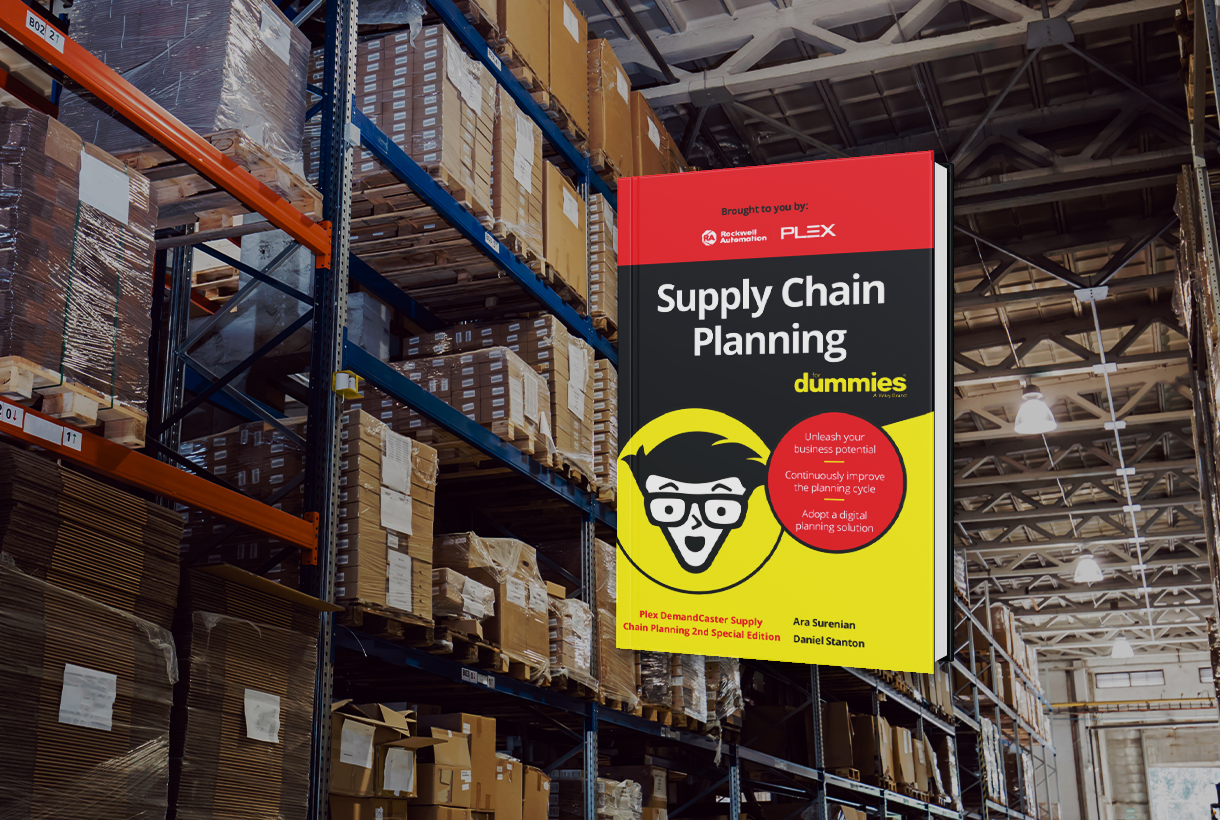What is Capacity Planning?
Capacity planning is the process whereby the production capacity needed to meet manufacturing demand is determined. It is essential for scheduling production to meet short- and medium-term demand and can also be used for long-term planning at the organizational and strategic levels.
Effective capacity planning is a must for any company, including large scale enterprises and small and medium sized businesses. It is linked to supply chain planning through the demand function and seeks to align production capacity with sales demand through the demand forecast. Because of this, demand forecasting is a fundamental part of capacity planning.
By using formulations to consider the number of machines, staff size, available shifts, product mix, utilization and efficiency, capacity can be calculated to determine whether a company will meet forecasted demand. This allows decision-makers to add or scale back capacity resources to improve overall efficiency and meet service commitments.
Why Do Companies Need to Plan Capacity?
Capacity planning is important because it directly impacts key budget centers. Operating costs are affected when demand and capacity are out of sync. Depending on how demand plays out, poorly planned capacity results in labor shortages and threatens the ability to meet service level commitments unless the company runs overtime. Or it could mean excess labor on the shop floor. Both result in an increased cost per unit.
Capacity also impacts fixed costs. For example, uncertain capacity may lead companies to add warehouse space or material handling equipment through leases or contracts. If demand does not match the capacity, they are then stuck with these fixed costs for a length of time adding overall cost to the product and placing.
Finally, capacity impacts capital expenditure decisions at the enterprise level. As most capital equipment is considered a fixed asset, choosing the wrong type of equipment or choosing to add that equipment in too few or too great a number means that capacity will still not meet demand. Matching capacity with demand through effective capacity planning improves operational efficiency and directly affects financial health.
How it Works
Today, capacity planning can be automated through software directly linked to supply chain planning. This allows decision-makers to view capacity at different operational levels. As demand is forecasted, capacity planning acts as the input for other production functions including aggregate planning, demand management, scheduling and shop floor control.
Capacity Planning may be done at different operational levels, depending on focus. In aggregate capacity planning, the company’s capacity requirements are calculated for a long period. This may range from 2-12 months and be adjusted within the period to keep labor requirements, utilization, resource allocation and unexpected changes in demand in line with capacity.
At the operations level, disaggregated capacity planning breaks down the aggregate plan into operational plans with shorter timeframes. The disaggregated plan results in a master schedule that can then be operationalized into shorter time buckets of months, weeks, days, shifts, etc. It includes breaking down capacity by product category, labor requirement, equipment and other variables.
Automated capacity planning is flexible and allows companies to look at capacity both holistically and locally. However, each level requires alignment with demand forecasting.
Benefits of Capacity Planning
There are many benefits with capacity planning. In addition, companies that use automated software for capacity planning will realize even greater benefits as it can be tied into supply chain planning to leverage better accuracy and deeper analytical capabilities. Some of the benefits of capacity planning include:
- Cost Monitoring – Capacity planning allows a company to better monitor costs. As the factors that go into capacity calculations are measured, variance can be identified, adjusted or corrected.
- Flexibility – With capacity planning linked to demand forecasting, capacity can be analyzed for seasonal trends and production requirements can be anticipated. Factors such as reduced or increased labor for seasonality, added capacity for anticipated products rollouts or planning for a product end of lifecycle can be leveraged to improve cost and efficiency.
- Growth Planning – With automated software, capacity can be planned with confidence. This helps decision-makers and C-suite executives plan for expansion and new locations based on accurate understanding of existing capacity based on demand forecasting.
- Improved Human Capital Management – With reliable demand forecasts, companies can ensure they have not only the right number of staff but also the right skill sets for the required capacity. This can be used to improve skill sets or cross-train staff.
- Increased Customer Service Levels– By aligning capacity with demand within the supply chain planning structure, service levels improve leading to happier customers and better brand reputation.
- Improved Profitability – When capacity and demand are aligned, gaps are reduced or eliminated in the manufacturing process. Proper equipment configuration, lower overtime costs, improved skill set utilization and other factors lead to lower cost per unit of production and translate to higher margins.
- Continuous Improvement Opportunities – Because capacity planning must measure multiple variables within manufacturing it can uncover constraints that may not have had visibility before. This provides context in areas that can be better optimized in the future. Continuous improvement of the process means more capacity with existing resources.
How Capacity Planning is Structured
The structure for capacity planning for an enterprise can be determined by three variables: measuring capacity, defining a planning strategy and determining which capacity planning technique will be used.
Measuring Capacity
Production rates must be measured to understand capacity. The measurement of capacity then becomes a function of the following:
- Design Capacity – Design capacity is considered the ideal production situation. It is the maximum output possible with production equipment and resources over a period of time.
- Effective Capacity – Effective capacity considers product mix, changes in product mix, anticipated maintenance, raw material disruptions and labor issues such as absenteeism and fatigue. Effective capacity is the maximum capacity possible given the influence of these factors.
- Actual Output – Actual output is the rate of production achieved.
These capacity measurements give planners a way to measure the effectiveness of the production system as a function of actual output over effective capacity (efficiency), or as actual output over design capacity (utilization).
Defining a Strategy
Every company needs a strategy for capacity planning. The chosen capacity strategy will be accepted by supply chain and manufacturing managers to ensure that everyone is using the same numbers and methodology. Possible capacity strategies include:
- Lead Capacity Strategy – A lead capacity strategy adds capacity prior to demand. It allows managers to increase capacity ahead of demand so that service levels can be met when demand hits. It is a good strategy for companies who encounter heavy seasonal demand and allows them to get ahead of the demand curve.
- Lag Capacity Strategy – A lag capacity strategy means a company adds capacity only after demand has occurred. A lag strategy is less risky on the front end because it holds back financial investment until needed. This can be a useful strategy if the company has a production system that is agile and can add capacity quickly. However, it may create production constraints if the increase in capacity requires additional capital expenditure for equipment or extensive training that will drag out the ability to increase capacity.
- Match Capacity Strategy – A match capacity strategy is an incremental increase in capacity that happens as volume increases. In ideal situations it can help balance the cost of increasing capacity and act as a “pay as you go” strategy. This may be a good choice for small and medium sized businesses with limited cash flow who have not scaled.
Determining a Technique
The capacity planning technique will be determined by the production system used. These may include:
- Capacity Using Overall Factors – This is a manual planning technique using a master schedule and production standards. Together, these two elements convert finished good units to historical loads on work centers.
- Capacity Bills – Bills of capacity use Bills of Material (BOM and routing sheets to determine where it is made and setup and run time of the work center.
- Resource Profiles – Resource profiles are like capacity bills but with lead time added
- Capacity Requirements Planning – Capacity requirements planning can only be used in systems using automated software such as MRP or ERP systems. It automates information using one of the three above techniques and integrates data such as inventory, lot size and other real-time production values available through the automated system.
Of the four techniques, the first three are rough cut methods. However, capacity requirements planning is the ideal method for automated software systems. It also allows use of finite and infinite capacity scheduling methods where simulations can be used to produce detailed schedules that correspond with the correct capacity needed to produce. This feature is often a functionality of advanced capacity and supply chain planning software that gives companies the advantage of dynamic capacity planning using real-time data.
What are the Steps for Capacity Planning?
How a company proceeds with capacity planning will depend on the tools available to them. If they are still using spreadsheets and fragmented disparate systems, then capacity will only be as good as the accuracy of that data and the speed in which it was assembled and analyzed. For companies using advanced supply chain management software, real-time data, advanced analytics and system interoperability will give companies a more focused and accurate capacity plan.
- Step 1 – Assess Current Capacity – This first step will include factors such as time studies and live data collection on equipment capabilities. It will also include number of hours and shifts available. It helps to include other factors such as estimates of absenteeism, employee fatigue factors based on movement studies and supply chain variables that include vendor performance, lead time and inventory.
- Step 2 – Develop a Strong Demand Plan – It is impossible to plan capacity without a reliable and accurate demand plan. The most accurate demand forecasts are those resulting from the use of supply chain planning software. This software allows aggregated demand forecasting and the disaggregation of those forecasts to departments and facilities for operationalization. Capacity and demand planning software platforms such as those by DemandCaster offer capabilities such as:
- Ability to calculate workcenter capacity by production time or units produced.
- Visualization of rough-cut capacity for identifying bottlenecks with both open and planned orders.
- Advanced capacity requirements planning for the use of “what-if” scenarios to identify potential capacity constraints.
- Master scheduling functionality with flexibility to use chase or level loading strategies
By using software for demand planning, companies can create actionable master production schedules that align production requirements with the supply chain.
- Step 3 – Determine Capacity Modification Requirements – With a clear demand plan and calculated understanding of capacity, companies can look at methods to adjust capacity to meet demand. This may take the form of additional shifts, overtime, sub-contracting of various aspects of production, or continuous improvement initiatives. And if demand is sustainable over a long period, capital expansion through equipment purchases or new facilities may be required.
Challenges in Capacity Planning
Meeting the demands of today’s manufacturing is difficult. For large companies, that difficulty may mean coordinating planning across large geographic regions. And for small and medium sized businesses it may mean managing demand while trying to scale. Regardless the operation, there are many challenges to capacity planning including:
- Complexity of Organization – Capacity planning can be more challenging in companies with complex organizational structures (such as those with multiple facilities or divisions making different categories of goods). It can also be challenging for those with very detailed Bills of Material (BOM) that require an excess of parts or processes to complete finished items.
- Data Collection – For demand forecasts and capacity to be in sync, data must be accurate. Increasing supply chain complexity due to external factors, coupled with production complexity internally means that data must be accurate, current and unsiloed across the organization. If data collection and integrity is not accurate, demand and capacity become more difficult to align.
- Operational Factors – As demand increases, equipment breakdowns may accelerate, and employee fatigue may increase. Even though these factors should be measured and included in a capacity plan, as the timeframe moves forward, adjustments may be made to account for unforeseen operational variables.
- Supply Chain Issues – Supply chain complexity has increased over the years due to many external factors like regulation, tariffs and others. Rapid shifts in vendors, quality of incoming raw material, logistics issues and other factors may impact the capacity in production as production adjusts to different mixes or blends or as additional processing equipment may be required.
What is the Value of Capacity Planning?
The goal of capacity planning is to match production capacity with customer sales demand. The challenges above can be met when production and capacity planning is conducted with reliable platforms that integrate within a company’s other systems such as an ERP. Supply chain planning software offers the benefits of real time data analysis, advanced planning algorithms and multi-level visualization to ensure capacity can be planned to meet demand. This results in the delivery of goods at the most effective cost per unit.


